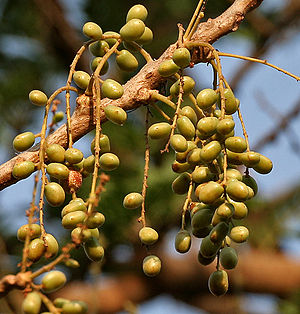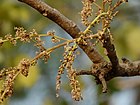Note: This is a project under development. The articles on this wiki are just being initiated and broadly incomplete. You can Help creating new pages.
Difference between revisions of "Lannea coromandelica - Jhingini"
(→References) |
(→References) |
||
| (8 intermediate revisions by the same user not shown) | |||
| Line 1: | Line 1: | ||
[[File:Lannea coromandelica (Wodier Tree) fruits in Hyderabd W IMG 7389.jpg|thumb|right|''Jhingini'', ''Lannea coromandelica'']] | [[File:Lannea coromandelica (Wodier Tree) fruits in Hyderabd W IMG 7389.jpg|thumb|right|''Jhingini'', ''Lannea coromandelica'']] | ||
| − | '''Jhingini''' is a deciduous tree usually growing 5 - 10 metres tall but with some specimens up to 20 metres tall with a bole 45cm in diameter. The leaves are gathered from the wild for local use as food and medicine. The plant is also cultivated in some areas of the tropics as a hedge plant and roadside tree | + | '''Jhingini''' is a deciduous tree usually growing 5 - 10 metres tall but with some specimens up to 20 metres tall with a bole 45cm in diameter. The leaves are gathered from the wild for local use as food and medicine. The plant is also cultivated in some areas of the tropics as a hedge plant and roadside tree. |
| − | |||
==Uses== | ==Uses== | ||
| − | {{Uses|Sprains}}, {{Uses|Inflammation}}, {{Uses|Cuts | + | {{Uses|Sprains}}, {{Uses|Inflammation}}, {{Uses|Cuts}}, {{Uses|Burns}}, {{Uses|Dysentery}} |
<ref name="Uses"/> | <ref name="Uses"/> | ||
| + | |||
| + | ===Food=== | ||
| + | Lannea coromandelica can be used in Food. Tender leaves are cooked as vegetable<ref name="Forest foods of Western Ghat"/> | ||
==Parts Used== | ==Parts Used== | ||
| Line 11: | Line 13: | ||
==Common names== | ==Common names== | ||
| − | {{Common names|kn= | + | {{Common names|kn=Ajashringi, Goddi mara, Dhumpaarikuratike|ml=Kalasu, Kalesjam, Karasu, Karayam, Otiyamaram, Thingam|sa=Ajasringgi, Jhingini, Gudamanjari, Netrashuddhi, Jhingi, Jivala, Kvala, Manjari|ta=Anaikarai, Vodiyar, Odiya-maram, Odiyan|te=Goompana chettu, Gumpena, Oddimanu, Dhumpari|hi=Jhingan, Kashmal|en=Indian ash tree}} |
<ref name="Common names"/> | <ref name="Common names"/> | ||
| Line 29: | Line 31: | ||
===Prabhava=== | ===Prabhava=== | ||
| + | |||
| + | ===Nutritional components=== | ||
| + | Lannea coromandelica Contains the Following nutritional components like - Ursolic acid; kaempferol, 3 β-D-galactoside, quercitrin, rutin, quercetin; Calcium, Iron, Magnesium, Phosphorus, Potassium, Sodium, Zinc<ref name="Forest foods of Western Ghat"/>. | ||
==Habit== | ==Habit== | ||
| Line 35: | Line 40: | ||
==Identification== | ==Identification== | ||
===Leaf=== | ===Leaf=== | ||
| − | {{Leaf|Pinnate| | + | {{Leaf|Pinnate|Alternate|Leaves bipinnate, alternate, stipulate, rachis 14.5-62.5 cm long, stout, with a gland at the tip. Pinnae 2-3 pairs, leaflets 8-20.}}<ref name="Leaf"/> |
===Flower=== | ===Flower=== | ||
| − | {{Flower|Axillary | | + | {{Flower|Axillary |Axillary or terminal racemes|Yellowish green|8|Male flowers : in compound racemes, 8 mm across; calyx 4-lobed; lobes ovate, imbricate, persistent. Flowering season is January to March}} |
===Fruit=== | ===Fruit=== | ||
| − | {{Fruit|A drupe|12 mm long|| | + | {{Fruit|A drupe|12 mm long||Ovoid, red; stone hard; seed compressed||Fruiting season is January to March}} |
===Other features=== | ===Other features=== | ||
==List of Ayurvedic medicine in which the herb is used== | ==List of Ayurvedic medicine in which the herb is used== | ||
| − | |||
==Where to get the saplings== | ==Where to get the saplings== | ||
| Line 53: | Line 57: | ||
==How to plant/cultivate== | ==How to plant/cultivate== | ||
| − | + | Seed - it has a short viability and so needs to be sown as soon as possible. Cuttings - very easy, even large branches usually root<ref name="Cultivation details"/>. Lannea coromandelica is available through August to December<ref name="Forest foods of Western Ghat"/>. | |
| − | Seed - it has a short viability and so needs to be sown as soon as possible. | ||
| − | Cuttings - very easy, even large branches usually root | ||
| − | <ref name="Cultivation details"/> | ||
==Commonly seen growing in areas== | ==Commonly seen growing in areas== | ||
| Line 72: | Line 73: | ||
==References== | ==References== | ||
| − | |||
<references> | <references> | ||
<ref name="Uses">[http://www.pitchandikulam-herbarium.org/contents/medicinal.php?id=108 Uses]</ref> | <ref name="Uses">[http://www.pitchandikulam-herbarium.org/contents/medicinal.php?id=108 Uses]</ref> | ||
| Line 78: | Line 78: | ||
<ref name="Common names">[http://envis.frlht.org/bot_search Vernacular names]</ref> | <ref name="Common names">[http://envis.frlht.org/bot_search Vernacular names]</ref> | ||
<ref name="Cultivation details">[http://tropical.theferns.info/viewtropical.php?id=Lannea+coromandelica Cultivation details]</ref> | <ref name="Cultivation details">[http://tropical.theferns.info/viewtropical.php?id=Lannea+coromandelica Cultivation details]</ref> | ||
| − | + | <ref name="Forest foods of Western Ghat">"Forest food for Northern region of Western Ghats" by Dr. Mandar N. Datar and Dr. Anuradha S. Upadhye, Page No.99, Published by Maharashtra Association for the Cultivation of Science (MACS) Agharkar Research Institute, Gopal Ganesh Agarkar Road, Pune</ref> | |
</references> | </references> | ||
==External Links== | ==External Links== | ||
| − | * [ | + | * [https://indiabiodiversity.org/species/show/230190 Lannea coromandelica on indiabiodiversity.org] |
| − | * [https://herbpathy.com/Uses-and-Benefits-of-Lannea-Coromandelica-Cid1204] | + | * [https://herbpathy.com/Uses-and-Benefits-of-Lannea-Coromandelica-Cid1204 Lannea coromandelica on herbpathy.com] |
[[Category:Herbs]] | [[Category:Herbs]] | ||
Latest revision as of 12:57, 10 November 2021
Jhingini is a deciduous tree usually growing 5 - 10 metres tall but with some specimens up to 20 metres tall with a bole 45cm in diameter. The leaves are gathered from the wild for local use as food and medicine. The plant is also cultivated in some areas of the tropics as a hedge plant and roadside tree.
Contents
- 1 Uses
- 2 Parts Used
- 3 Chemical Composition
- 4 Common names
- 5 Properties
- 6 Habit
- 7 Identification
- 8 List of Ayurvedic medicine in which the herb is used
- 9 Where to get the saplings
- 10 Mode of Propagation
- 11 How to plant/cultivate
- 12 Commonly seen growing in areas
- 13 Photo Gallery
- 14 References
- 15 External Links
Uses
Sprains, Inflammation, Cuts, Burns, Dysentery [1]
Food
Lannea coromandelica can be used in Food. Tender leaves are cooked as vegetable[2]
Parts Used
Chemical Composition
Common names
| Language | Common name |
|---|---|
| Kannada | Ajashringi, Goddi mara, Dhumpaarikuratike |
| Hindi | Jhingan, Kashmal |
| Malayalam | Kalasu, Kalesjam, Karasu, Karayam, Otiyamaram, Thingam |
| Tamil | Anaikarai, Vodiyar, Odiya-maram, Odiyan |
| Telugu | Goompana chettu, Gumpena, Oddimanu, Dhumpari |
| Marathi | NA |
| Gujarathi | NA |
| Punjabi | NA |
| Kashmiri | NA |
| Sanskrit | Ajasringgi, Jhingini, Gudamanjari, Netrashuddhi, Jhingi, Jivala, Kvala, Manjari |
| English | Indian ash tree |
Properties
Reference: Dravya - Substance, Rasa - Taste, Guna - Qualities, Veerya - Potency, Vipaka - Post-digesion effect, Karma - Pharmacological activity, Prabhava - Therepeutics.
Dravya
Rasa
Guna
Veerya
Vipaka
Karma
Prabhava
Nutritional components
Lannea coromandelica Contains the Following nutritional components like - Ursolic acid; kaempferol, 3 β-D-galactoside, quercitrin, rutin, quercetin; Calcium, Iron, Magnesium, Phosphorus, Potassium, Sodium, Zinc[2].
Habit
Identification
Leaf
| Kind | Shape | Feature |
|---|---|---|
| Pinnate | Alternate | Leaves bipinnate, alternate, stipulate, rachis 14.5-62.5 cm long, stout, with a gland at the tip. Pinnae 2-3 pairs, leaflets 8-20. |
Flower
| Type | Size | Color and composition | Stamen | More information |
|---|---|---|---|---|
| Axillary | Axillary or terminal racemes | Yellowish green | 8 | Male flowers : in compound racemes, 8 mm across; calyx 4-lobed; lobes ovate, imbricate, persistent. Flowering season is January to March |
Fruit
| Type | Size | Mass | Appearance | Seeds | More information |
|---|---|---|---|---|---|
| A drupe | 12 mm long | Ovoid, red; stone hard; seed compressed | Fruiting season is January to March |
Other features
List of Ayurvedic medicine in which the herb is used
Where to get the saplings
Mode of Propagation
How to plant/cultivate
Seed - it has a short viability and so needs to be sown as soon as possible. Cuttings - very easy, even large branches usually root[5]. Lannea coromandelica is available through August to December[2].
Commonly seen growing in areas
Tropical area, Sub tropical area
Photo Gallery
References
- ↑ Uses
- ↑ 2.0 2.1 2.2 "Forest food for Northern region of Western Ghats" by Dr. Mandar N. Datar and Dr. Anuradha S. Upadhye, Page No.99, Published by Maharashtra Association for the Cultivation of Science (MACS) Agharkar Research Institute, Gopal Ganesh Agarkar Road, Pune
- ↑ Vernacular names
- ↑ Botonic description
- ↑ Cultivation details
External Links
- Ayurvedic Herbs known to be helpful to treat Sprains
- Ayurvedic Herbs known to be helpful to treat Inflammation
- Ayurvedic Herbs known to be helpful to treat Cuts
- Ayurvedic Herbs known to be helpful to treat Burns
- Ayurvedic Herbs known to be helpful to treat Dysentery
- Herbs with Bark used in medicine
- Herbs with Leaves used in medicine
- Herbs with common name in Kannada
- Herbs with common name in Hindi
- Herbs with common name in Malayalam
- Herbs with common name in Tamil
- Herbs with common name in Telugu
- Herbs with common name in Sanskrit
- Herbs with common name in English
- Habit - Tree
- Index of Plants which can be propagated by Seeds
- Index of Plants which can be propagated by Cuttings
- Herbs that are commonly seen in the region of Tropical area
- Herbs that are commonly seen in the region of Sub tropical area
- Herbs
- Plants of western ghats
- Anacardiaceae
- Ayurvedic herbs that don't have seed photos





